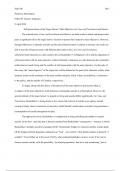Essay
Self-preservation on the Tragic Heroes’ Main Objective in Crime and Punishment and Hamlet
- Course
- ENG150 (ENG150)
- Institution
- University Of Toronto (U Of T )
Final ENG150 compare and contrast essay on "Hamlet" and "Crime and Punishment" for the University of Toronto. The essay received an A as the final grade in 2023.
[Show more]



